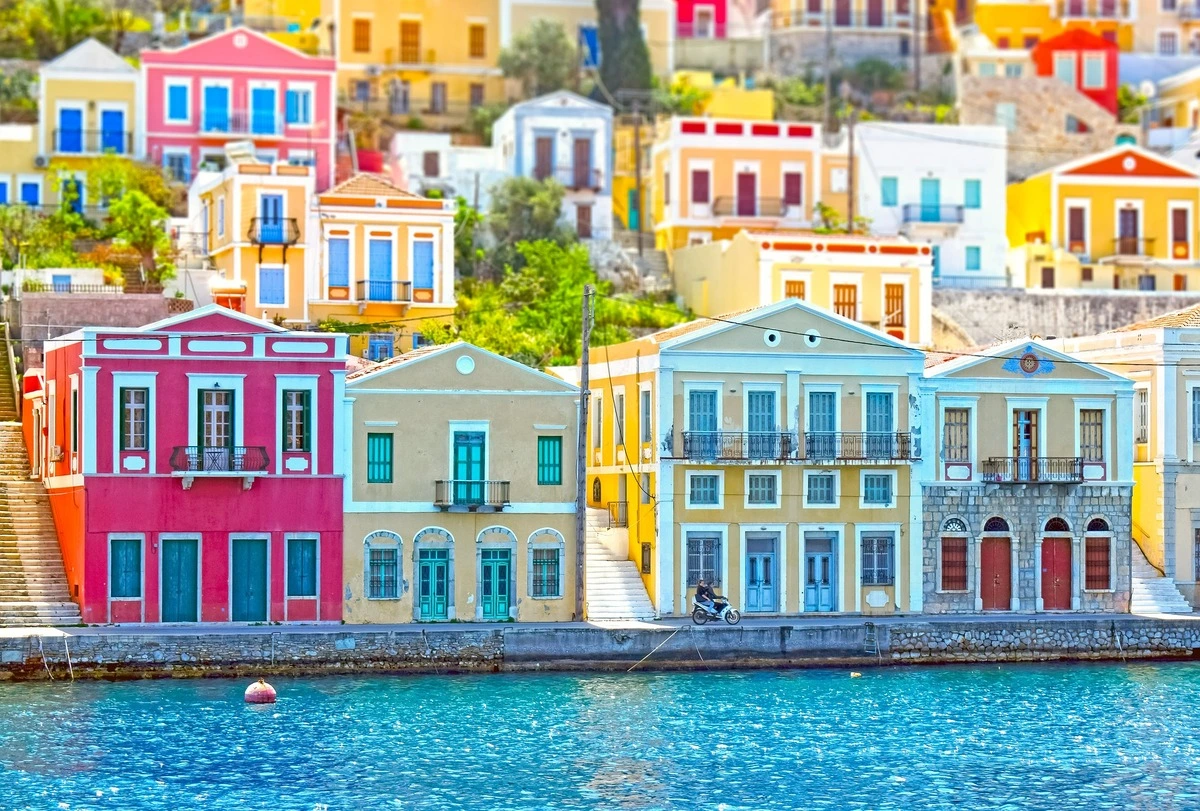
Symi | A Sunny Dodecanese Island
Symi’s history goes back to the Trojan Wars (1120 BC). Numerous invaders, from the Dorians, the Romans, the Turks, and the Italians, made Symi a strategically important island.
Before the Italian invasion, Symi’s population of about 22,500 inhabitants prospered with ship-building, sponge fishing, wine-making, and wood carving. In 1947, Symi and the rest of the Dodecanese islands became part of Greece. Now its primary industry is tourism.

Climate
Symi, Greece, is one of the warmest Dodecanese islands. In the summer, temperatures regularly reach over 40 °C. The winter months are much rainier than the summer months.
Since Symi is in the eastern part of the Aegean Sea, it is less affected by the Meltemi. The Meltemi is the strong northerly wind that blows in summer on the central Aegean Sea.
Places to see on Symi
- Harbor Town of Symi: The island’s main attraction is the charming harbor town of Symi. It is famous for its neoclassical architecture, colorful facades, and serene ambiance. As you approach the harbor on your yacht, you’ll see a captivating panorama of pastel-colored buildings cascading down the hillsides.
- Pedi Village is a small traditional fishing village with a stony beach and fine soft sand.
- Emporios (Nimporios) Village was a commercial harbor in ancient times. Today, it’s one of Symi’s most picturesque fishing settlements, with an attractive pebbled beach.
- The Holy Monastery of Archangel Michael Panormitis. Located on the southern coast of Symi, the Panormitis Monastery is a sacred pilgrimage site dedicated to the Archangel Michael. The monastery’s stunning architecture, serene courtyards, and intricate frescoes make it a must-visit destination. It’s also home to a notable ecclesiastical museum and a library with valuable manuscripts.
- The Monastery of the Archangel Michael at Roukouniotis.
- Byzantine Wine Presses. There are more than 130 stone wine presses on Symi. They are in the cypress forests in the southern lowland (Ambeli) around Sotiri to Magalou and stretch across to Kourkouniotis.
- The Naval Museum has old maps and model ships. These and other things tell the story of the island’s history with the sea and sponge fishing.
- The Archaeological Museum of Symi.
Things to do on Symi
- Climb Kali Strata, the main stairway from Gialos to Chorio, where you’ll find gorgeous views over the bay.
- Hiking Adventures: Embark on hiking trails that offer breathtaking views of Symi’s landscapes, hills, and the Aegean Sea.
- Swim. Marathounda Beach is suitable for both swimming and snorkeling.
- Go to the beach. Famous beaches include Nos Beach, Nimporios Beach, Pedi Beach, Gialos Beach, and Panormitis Beach.
- Scuba Dive. The crystal-clear waters surrounding the island offer excellent opportunities for diving and exploring the underwater world. Several diving centers and schools on the island cater to divers of various experience levels, from beginners to advanced divers.
- Birdwatch. The island’s diverse landscape provides a habitat for various bird species. Birdwatchers can spot both resident and migratory birds, especially during the spring and autumn migration seasons.
Gastronomy
The cuisine of Symi reflects its proximity to the sea. There are abundant fresh fish, shrimp, octopus, squid, and fresh vegetables and grains.
Many places here offer fresh fish. Also local food like chickpeas with mushrooms, dill, and rolls made from grape leaves filled with white cabbage. Fish dishes may be the first choice on the island. However, it’s worth a try if you find a local casserole goat.
As for sweets, try Misokofti. A traditional Greek dessert. It’s a kind of mustalevria, which is a Greek dessert that’s like pudding. In fact, they make the dessert from the inside of prickly pears, cornstarch, and sugar.
